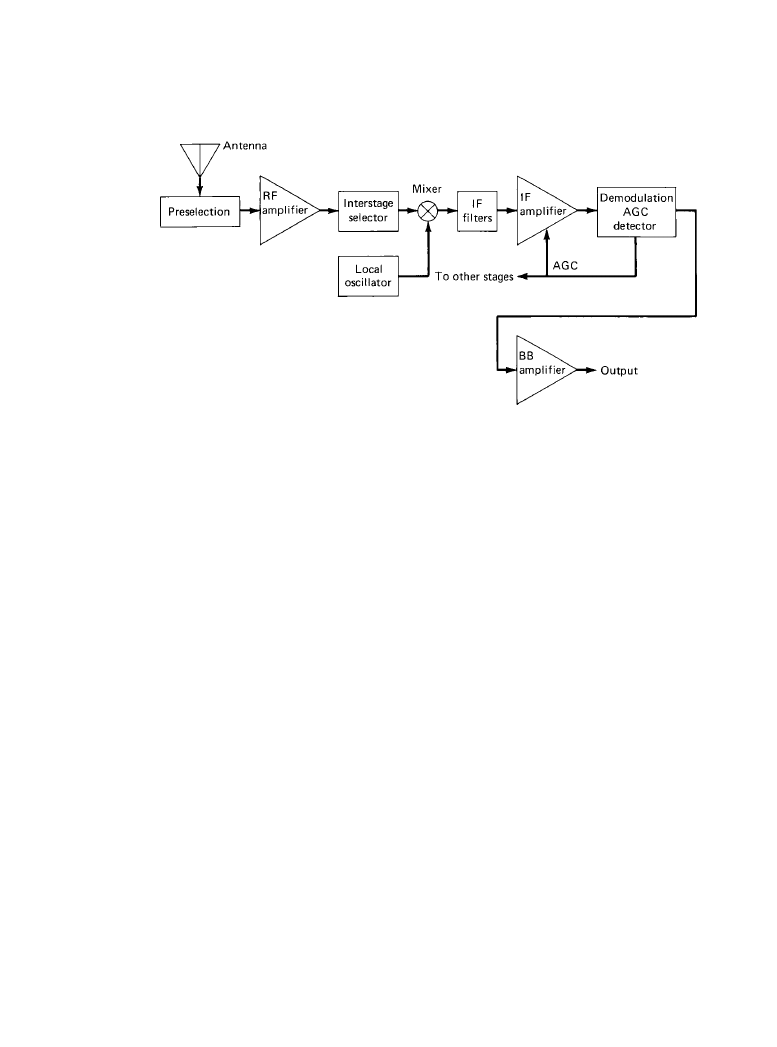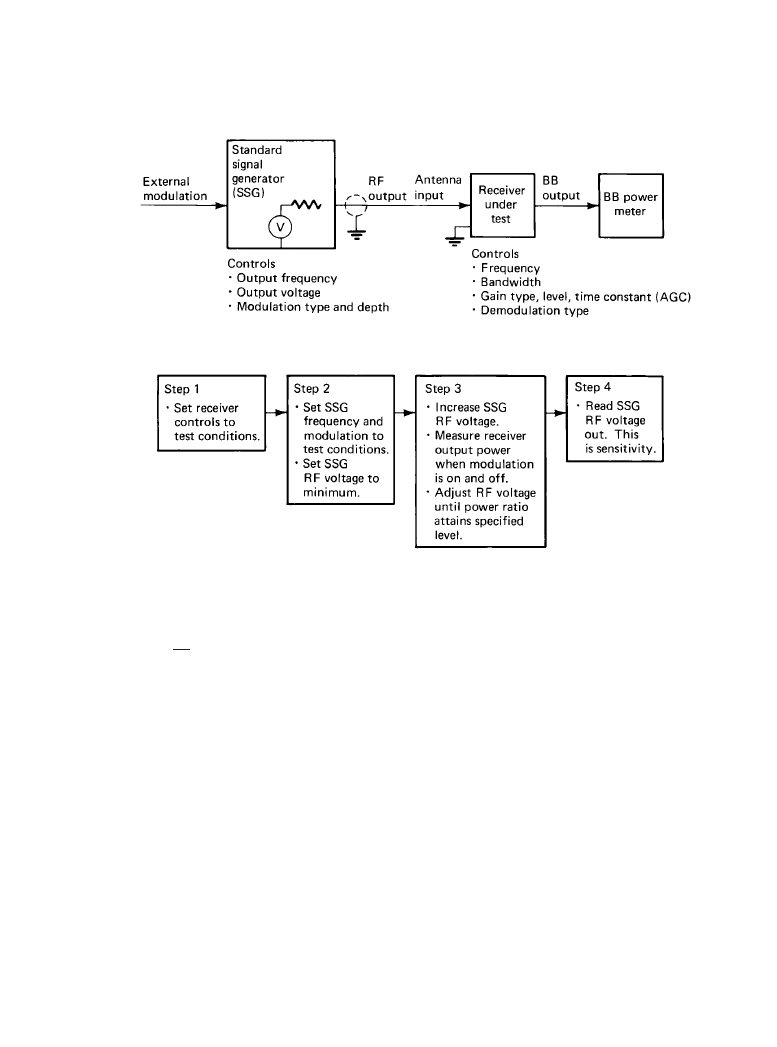ВУЗ: Казахская Национальная Академия Искусств им. Т. Жургенова
Категория: Книга
Дисциплина: Не указана
Добавлен: 03.02.2019
Просмотров: 21627
Скачиваний: 19

12-8 Broadcast Receiver Systems
12.1.1a Practical Receivers
Because of the nature of active electronic devices, it is generally easier to provide high stable
gain in a fixed-frequency amplifier than in a tunable one, and gain is generally more economical
at lower frequencies. Thus, although the superheterodyne receiver does introduce a problem of
spurious responses not present in the other receiver types, its advantages are such that it has
replaced other types except for special applications.
Referring again to Figure 12.1.1, the signal is fed from the antenna to a preselector filter and
amplifier. The input circuit is aimed at matching the antenna to the first amplifying device so as
to achieve the best sensitivity while providing sufficient selectivity to reduce the probability of
overload from strong undesired signals in the first amplifier. Losses from the antenna coupling
circuit and preselection filters decrease the sensitivity. Because sufficient selectivity must be
provided against the image and other principal spurious responses prior to the mixing circuit, the
preselection filtering is often broken into two or more parts with intervening amplifiers to mini-
mize the effects of the filter loss on the noise factor (NF). The LO provides a strong stable signal
at the proper frequency to convert the signal frequency to IF. This conversion occurs in the mixer.
(This element has also been referred to as the first detector, converter, or frequency changer.)
The output from the mixer is applied to the IF amplifier, which amplifies the signal to a suit-
able power level for the demodulator. This circuit derives from the IF signal the modulation sig-
nal, which may be amplified by the baseband amplifier to the level required for output.
Normally, the output of an audio amplifier is fed to a headphone or loudspeaker at the radio, or
coupled to a transmission line for remote use. A video signal requires development of sweep,
intensity, and usually color signals from the amplified video demodulation prior to display. In
other cases, the output may be supplied to a data demodulator to produce digital data signals
from the baseband signal. The data demodulator may be part of the receiver or may be provided
separately as part of a data modem. The data modem may also be fed directly from the receiver at
IF. Data demodulation is typically accomplished using digital processing circuits rather than ana-
Figure 12.1.1
Block diagram of a superheterodyne receiver.
Downloaded from Digital Engineering Library @ McGraw-Hill (www.digitalengineeringlibrary.com)
Copyright © 2004 The McGraw-Hill Companies. All rights reserved.
Any use is subject to the Terms of Use as given at the website.
Receiver Characteristics

Receiver Characteristics 12-9
log demodulators and amplifiers. In this case, the IF amplifier must be designed to provide the
appropriate level to an A/D converter so that digital processing can be carried out. Additional IF
filtering, data demodulation, and error control coding can all be performed by digital circuits or
a microprocessor, either in the receiver or as part of an external modem.
An alternative to IF sampling and A/D conversion is the conversion of the signal to baseband
in two separate coherent demodulators driven by quadrature LO signals at the IF. The two out-
puts are then sampled at the appropriate rate for the baseband by two A/D converters or a single
multiplexed A/D converter, providing the in-phase and quadrature samples of the baseband sig-
nal. Once digitized, these components can be processed digitally to provide filtering, frequency
changing, phase and timing recovery, data demodulation, and error control.
12.1.2 The Receiving System
The first essential function of any radio receiver is to effect the transfer of energy picked up by
the antenna to the receiver itself through the input circuits. Maximum energy is transferred if the
impedance of the input circuit matches that of the antenna (inverse reactance and same resis-
tance) throughout the frequency band of the desired signal. This is not always feasible, and the
best energy transfer is not essential in all cases. A receiver may also be connected with other
receivers through a hybrid or active multicoupler to a single antenna. Such arrangements are
sometimes very sensitive to mismatches.
There are at least three antenna matching problems in a receiver. The first and, in many cases,
most crucial problem is that the receiver may be used from time to time with different antennas
whose impedances the potential users cannot specify fully. Second, antennas may be used in
mobile applications or in locations subject to changing foliage, buildings, or waves at sea, so that
the impedance—even if measured accurately at one time—is subject to change from time to
time. Third, at some frequencies, the problems of matching antennas are severely limited by
available components, and the losses in a matching network may prove greater than for a simpler
lower-loss network with poorer match.
When antenna matching is important over a wide band, it may be necessary to design a net-
work that can be tuned mechanically or electrically under either manual or automatic control in
response to a performance measure in the system. In older receivers with a wide tuning range, it
was common to have a mechanically tuned preselector that could be adjusted by hand and was
generally connected directly to the variable-frequency oscillator (VFO) used for the first conver-
sion. At times a trimmer was used in the first circuit to compensate for small antenna mis-
matches. Thus, tuning of the circuit could be modified to match the effects of the expected
antenna impedance range. Modern wide tuning receivers often use one-half-octave switchable
filters in the preselector, which may be harder to match, but are much easier to control by com-
puter. Similarly, the first oscillator is generally a microprocessor-controlled synthesizer.
Often the problem of antenna matching design is solved by the user specification that defines
one or more “dummy antenna” impedances to be used with a signal generator to test the perfor-
mance of the receiver for different receiver input circuits. In this case, the user’s system is
designed to allow for the mismatch losses in performance that result from the use of actual
antennas. When it is necessary to measure receiver input impedance accurately, it is best accom-
plished through a network analyzer.
Downloaded from Digital Engineering Library @ McGraw-Hill (www.digitalengineeringlibrary.com)
Copyright © 2004 The McGraw-Hill Companies. All rights reserved.
Any use is subject to the Terms of Use as given at the website.
Receiver Characteristics

12-10 Broadcast Receiver Systems
A number of other receiver input considerations may occur in certain cases. The input circuits
may be balanced or unbalanced, or may need to be connectable either way. The input circuits may
require grounding, isolation from ground, or either connection. The circuits may need protection
from high-voltage discharges or from impulses. They may need to handle, without destruction,
high-power nearby signals, both tuned to the receiver frequency and off-tune. Thus, the input cir-
cuit can—at times—present significant design challenges.
12.1.2a
Gain, Sensitivity, and Noise Figure
Any given receiver is usually required to receive and process a wide range of signal powers, but
in most cases it is important that they be capable of receiving distant signals whose power has
been attenuated billions of times during transmission. The extent to which such signals can be
received usefully is determined by the noise levels received by the antenna (natural and man-
made) and those generated within the receiver itself. It is also necessary that the receiver produce
a level of output power suitable for the application. Generally the ratio of the output power of a
device to the input power is known as the gain. The design of a receiver includes gain distribu-
tion among the various stages so as to provide adequate receiver gain and an optimum compro-
mise among the other operating characteristics.
While there are limits to the amount of gain that can be achieved practically at one frequency
because of feedback, modern receivers need not be gain-limited. When the gain is sufficiently
high, the weakest signal power that may be processed satisfactorily is noise-limited. This signal
level is referred to as the sensitivity of the system at a particular time and varies depending on the
external noise level. It is possible in some systems for the external noise to fall sufficiently so
that the system sensitivity is established by the internal noise of the receiver. A receiver’s sensi-
tivity is one of its most important characteristics. There are no universal standards for its mea-
surement, although standards have been adopted for specific applications and by specific user
groups. Figure 12.1.2 shows a block diagram of the test setup and the typical steps involved in
determining receiver sensitivity.
NF
Sensitivity measures depend upon specific signal characteristics. The NF measures the effects of
inherent receiver noise in a different manner. Essentially it compares the total receiver noise with
the noise that would be present if the receiver generated no noise. This ratio is sometimes called
the noise factor F, and when expressed in dB, the NF. F is also defined equivalently as the ratio of
the S/N of the receiver output to the S/N of the source. The source generally used to test receivers
is a signal generator at local room temperature. An antenna, which receives not only signals but
noises from the atmosphere, the galaxy, and man-made sources, is unsuitable to provide a mea-
sure of receiver NF. However, the NF required of the receiver from a system viewpoint depends
on the expected S/N from the antenna. The effects of external noise are sometimes expressed as
an equivalent antenna NF.
For the receiver, we are concerned with internal noise sources. Passive devices such as con-
ductors generate noise as a result of the continuous thermal motion of the free electrons. This
type of noise is referred to generally as thermal noise, and is sometimes called Johnson noise
after the person who first demonstrated it. Using the statistical theory of thermodynamics,
Nyquist showed that the mean-square thermal noise voltage generated by any impedance
between two frequencies f
1
and f
2
can be expressed as
Downloaded from Digital Engineering Library @ McGraw-Hill (www.digitalengineeringlibrary.com)
Copyright © 2004 The McGraw-Hill Companies. All rights reserved.
Any use is subject to the Terms of Use as given at the website.
Receiver Characteristics

Receiver Characteristics 12-11
(12.1.1)
where R(f) is the resistive component of the impedance.
Magnetic substances also produce noise, depending upon the residual magnetization and the
applied dc and RF voltages. This is referred to as the Barkhausen effect, or Barkhausen noise.
The greatest source of receiver noise, however, is generally that generated in semiconductors.
Like the older thermionic tubes, transistors and diodes also produce characteristic noise. Shot
noise resulting from the fluctuations in the carrier flow in semiconductor devices produces wide-
band noise, similar to thermal noise. Low-frequency noise or 1/f noise, also called flicker effect,
is roughly inversely proportional to frequency and is similar to the contact noise in contact resis-
tors. All of these noise sources contribute to the “excess noise” of the receiver, which causes the
NF to exceed 0 dB.
The NF is often measured in a setup similar to that of Figure 12.1.2, using a specially
designed and calibrated white-noise generator as the input. The receiver is tuned to the correct
frequency and bandwidth, and the output power meter is driven from a linear demodulator or the
V
k t
R f
d f
n
f
f
2
4
1
2
=
∫
(
)
(
a)
(
b)
Figure 12.1.2
Receiver sensitivity measurement: (
a) test setup, (b) procedure.
Downloaded from Digital Engineering Library @ McGraw-Hill (www.digitalengineeringlibrary.com)
Copyright © 2004 The McGraw-Hill Companies. All rights reserved.
Any use is subject to the Terms of Use as given at the website.
Receiver Characteristics

12-12 Broadcast Receiver Systems
final IF amplifier. The signal generator is set to produce no output, and the output power is
observed. The generator output is then increased until the output has risen 3 dB. The setting on
the generator is the NF in decibels.
The NF of an amplifier can also be calculated as the ratio of input to output S/N, per the equa-
tion
(12.1.2)
where NF is the noise figure in dB and (S/N)
1
and (S/N)
2
are the amplifier input and output SNR,
respectively.
The NF for a noiseless amplifier or lossless passive device is 0 dB; it is always positive for
nonideal devices. The NF of a lossy passive device is numerically equal to the device insertion
loss. If the input of a nonideal amplifier of gain G (dB) and noise figure NF (dB) were connected
to a matched resistor, the amplifier output noise power P
No
(dB) would be
(12.1.3)
where k is Boltzmann’s constant (mW/°K), T is the resistor temperature in °K, and B is the noise
bandwidth in Hz.
When amplifiers are cascaded, the noise power rises toward the output as noise from succeed-
ing stages is added to the system. Under the assumption that noise powers add noncoherently, the
noise figure NF
T
of a cascade consisting of two stages of numerical gain A
1
and A
2
and noise
factor N
1
and N
2
, is given by Friis’ equation
(12.1.4)
where the noise factor is N = 10
(NF/10)
and the numerical gain is A = 10
(G/10)
. The system NF,
therefore, is largely determined by the first stage NF when A
1
is large enough to make
much smaller than N
1
.
Minimum Detectable Signal
Another measure of sensitivity is the minimum detectable signal (MDS). The measurement pro-
cedure is similar to the NF measurement except that a sinusoidal signal generator replaces the
noise generator to produce the doubling of output power over noise power alone. This signal
NF
S
N
S
N
=
10
1
0
log
(
)
(
)
P
kT
B
G
NF
No
=
+
+ +
10
10
log (
)
log ( )
NF
N
N
A
T
=
+
10
1
1
2
1
log
(
– )
N
(
2
1
) A
1
⁄
–
Downloaded from Digital Engineering Library @ McGraw-Hill (www.digitalengineeringlibrary.com)
Copyright © 2004 The McGraw-Hill Companies. All rights reserved.
Any use is subject to the Terms of Use as given at the website.
Receiver Characteristics